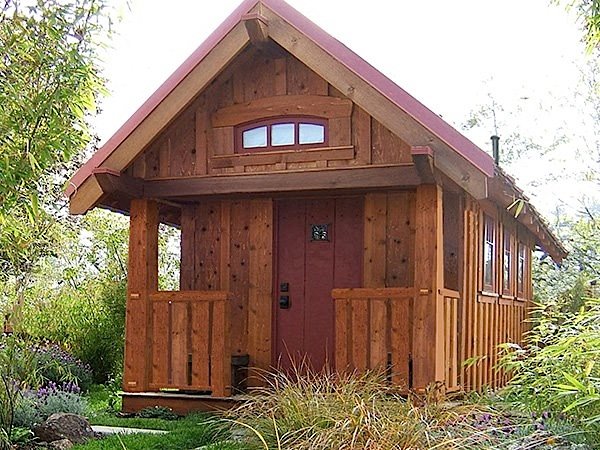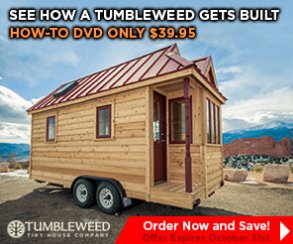April 20, 2013 | Posted in Tiny Houses | By Joanne
Living In Tiny (Or Small) House In The USA
They are houses that are very small in size. Much smaller than the average house in the U.S.
The cost of living is extremely low, maintenance costs are low, and they leave you with more time and money to enjoy life.
People are slowly beginning to realize that owning a huge home that will take 30 years to pay off, and that will require maintenance costs even longer than that, is not the way to go. Some people are even finding that you don’t even need to own land to have a place to call home.
How Tiny is Tiny?
Tiny houses are generally less than 300 square feet. Small houses can be classified as 1000 square feet or less. Some of the houses that are really tiny are placed at a permanent location, whereas others are mounted on trailers so that they can be moved easily whenever the need arises.
The Trend Toward a Smaller Home
The recent housing crisis throughout the USA has caused many people to sit back and think about what they really want out of a home. Many people have lost their home due to the economic downturn and mortgage crisis.
Having a huge house is not the most important thing to a lot of people anymore. What they have come to realize is that is the financial freedom that is found when they no longer have a mortgage payment is much more important.
Build Your Own Home
Tiny house plans are simple enough that most people can build their house by themselves. You don’t necessarily need to hire a contractor and pay someone to build the home of your dreams. You have choices; you can buy a do-yourself plan and build it yourself, you can buy a prefab small house and have it set on your property, or you can have someone build it for you. Most of these homes only require around 14 tools to build; many of which you may already have.
The prefab kits are meant to be built upon some kind of foundation. That foundation can be a cement slab, a wooden foundation, or a trailer. No matter what you choose as the foundation, your tiny home can be put together quickly and easily. Most prefabs already have finished exteriors and the windows preinstalled, so your house can be built in a matter of days. Your neighbors may be gone for a long weekend and come home to find your house is complete.
Many of the tiny house are built using structural insulated panels (SIP) construction. This type of construction is usually less costly than traditional construction. Insulation is already installed and the pieces are precut to fit the site, which means that there is less job site waste due to precut panels.
Housing you Can Afford
 If affordable housing is your goal, you’ll be happy to know that the majority of tiny houses can be built for under $20,000 if you do some or all of the building yourself.
If affordable housing is your goal, you’ll be happy to know that the majority of tiny houses can be built for under $20,000 if you do some or all of the building yourself.
There are many plans from tiny house companies in the USA that you can choose from. Most people don’t even realize that living debt free really can happen at anytime in your life if you rid yourself of huge monthly housing payments.
Go “Green”
People who enjoy doing things “” will be happy to know that many of these homes can be built with recycled materials.
When choosing to use items had been preused, make sure that you know what it was used for. For example, items such as wood pallets are well known these days for being reused for all kinds of things. However, some of them have been treated with chemicals and should not be reused. You need to be aware of the dangers that could come with previously used materials when planning your diy home.
Overall Downsides of Tiny Living
As with anything, there are a few downsides to living the tiny life. The most obvious is that there is not a lot of room inside. You need to organize and be organized. When building your home, you should incorporate storage space.
Having only the essentials will be important. If you have a hobby or require a place for extra curricular activities, you will need to decide if tiny or small is better for you.
The average American family size is four people. The general consensus is that a growing family would not be happy in a tiny house (although there are exceptions). They are better suited to single people, a couple, or a family of three. Anything larger would need careful consideration.
Overall Benefits of Tiny Living
One of the benefits of living the tiny life is the good that it is doing for the environment. The average house in the US produces tons of construction waste, and takes almost an entire acre of forest to build. A smaller home uses considerably less.
Freeing yourself from debt, and the monthly expense of a large home ownership are huge benefits of tiny house living. Not only will you have less expense, you will have less stuff. The fact that there just isn’t room in your small home to fit more stuff will stop you from purchasing things that you don’t really need.
Learning how to live creatively in a small space can be fun and rewarding. Add to that the benefit of being self-contained and if it was built to be mobile – being able to move the house wherever you want at any time with little effort.
Maintenance of the house will be much less. Just the task of vacuuming or mopping a floor alone will take a lot less time.
Buying things like flooring and a counter top for a smaller area will mean that any renovation or upgrading costs will be a lot less than they would be in a large house. You can splurge on the nicer wood floor or a marble counter top.
Energy bills will be much less for a smaller home. It doesn’t take much to heat or cool a home that is less than 1000 square feet.
The housing market trends are leading us into the tiny house movement. People are realizing that they don’t need a huge house to be happy. As long as they have a roof over their head and enough space for their family, they can be perfectly content. And most people living in tiny houses are not complaining about the task of making a monthly payment to the bank!
Are you interested in having a better quality of life? Take a look at some of the tiny house books where you can get a good idea of what is involved and the benefits of tiny houses.



